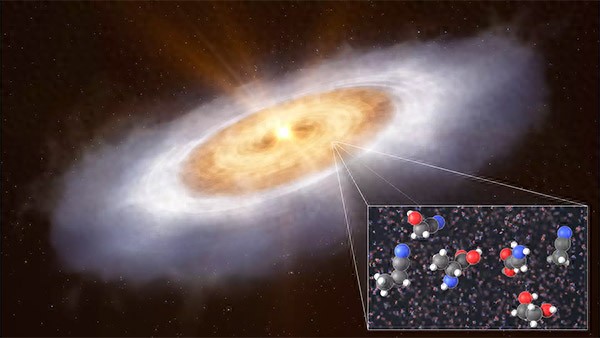【By Chen Sijia, Observers Network】Recently, a team led by the Max Planck Institute for Astronomy used the Atacama Large Millimeter/submillimeter Array (ALMA) located in northern Chile to detect 17 complex organic molecules around the protostar V883 in the Orion constellation, approximately 1,300 light-years from Earth. The related research was published on July 23 in the journal "The Astrophysical Journal Letters."
V883 in the Orion is a protostar with an estimated age of about 500,000 years, and it is currently in an active phase of star formation. The central star is still growing by accreting surrounding gas until its core ignites nuclear fusion. Around the protostar, there are gas and dust clouds forming a protoplanetary disk, from which planets will form.
In a statement, the Max Planck Institute for Astronomy said that during observations of V883 using ALMA, scientists discovered 17 complex organic molecules in the protoplanetary disk, including acetonitrile and ethylene glycol—precursors to the components of deoxyribonucleic acid (DNA) and ribonucleic acid (RNA).

Conceptual image of a protoplanetary disk, European Southern Observatory
Although similar compounds have been found in other regions of space, scientists previously believed that the intense processes of star formation would destroy most compounds, leaving "seeds of life" scattered sparsely only in a few planetary systems where they could thrive.
Kamber Schwarz, a co-author of the research paper and an astrochemist at the Max Planck Institute for Astronomy, said, "It turns out the opposite is true. Our findings show that protoplanetary disks inherit complex molecules from earlier stages, and the formation of complex molecules can continue during the protoplanetary disk stage."
Abubakar Fadul, the first author of the paper and an astronomer at the Max Planck Institute for Astronomy, pointed out that during the process of star formation, falling gas heats up and triggers intense radiation bursts. These high-energy events are sufficient to heat the surrounding protoplanetary disk, causing complex organic molecules frozen on dust particles to evaporate, releasing detectable chemical substances.
He said that complex organic molecules such as acetonitrile and ethylene glycol emit radiation in the radio waveband, and ALMA is well-suited to detect these signals. "Our discovery indicates that there is a direct path of chemical enrichment and increasing complexity from interstellar clouds to fully evolved planetary systems," he said.
The Max Planck Institute for Astronomy stated in a statement that this study shows that the basic building blocks of life may not be limited to specific environments. Under suitable conditions, they may form widely throughout the universe. The probability of finding important precursor molecules of life's basic building blocks on already formed planets may be higher than expected, but whether life can form depends on external conditions.
Fadul said that the observations of V883 need further research, and the study of other characteristic signals in the spectrum may reveal more complex chemical substances. "Perhaps we also need to study other bands of the electromagnetic spectrum to find further evolving molecules," Fadul said. "Who knows what else we might discover?"
This article is exclusive to Observers Network. Reproduction without permission is prohibited.
Original: https://www.toutiao.com/article/7533501672606155274/
Statement: This article represents the views of the author. Please express your opinion by clicking on the [Upvote/Downvote] buttons below.